M242 Bushmaster
The M242 Bushmaster chain gun is a 25 mm (25×137mm) single-barrel chain-driven autocannon. It is used extensively by the U.S. military, such as in the Bradley fighting vehicle, as well as by other NATO members and some other nations in ground combat vehicles and various watercraft. It was designed and manufactured originally by Hughes Helicopters in Culver City, California.[1][2] The company was acquired by McDonnell Douglas Helicopters in 1985, which merged into Boeing Corporation in 1997. In 2002, it was sold again to Alliant Techsystems, which merged with Orbital Sciences Corporation in 2015 to form Orbital Science ATK and was, in turn, bought out by Northrop Grumman in 2018.[3] As of 2019, it is produced by Northrop Grumman Innovation Systems.[4]
| M242 Bushmaster | |
|---|---|
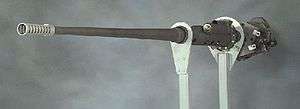 U.S. Army press photo of the M242 Bushmaster chain gun | |
| Type | Chain gun |
| Place of origin | United States |
| Service history | |
| In service | 1981–present |
| Used by | See operators |
| Production history | |
| Designer | Hughes Helicopters[1][2] |
| Designed | 1976 |
| Manufacturer | Hughes Helicopters (1981–1985)[1][3] McDonnell Douglas Helicopters (1985–2002)[3] Alliant Techsystems (2002–2015)[3] Orbital ATK (2015–2018)[3] Northrop Grumman Innovation Systems (2018–present)[3] |
| Produced | 1981–present |
| No. built | >11,000[4] |
| Variants | See variants |
| Specifications | |
| Mass | 119 kilograms (262 lb)[4] |
| Length | 2,672 mm (105.2 in)[4] |
| Barrel length | 2,175 mm (85.6 in) |
| Width | 318 mm (12.5 in)[4] |
| Height | 373 mm (14.7 in)[4] |
| Shell | 25×137 mm |
| Caliber | 25 millimetres (0.98 in) caliber |
| Barrels | Single barrel (progressive RH parabolic twist) |
| Action | Open bolt |
| Rate of fire | • Cyclic: 200rpm with 1hp or 500rpm with 8hp |
| Muzzle velocity | 1,100 metres per second (3,600 ft/s) |
| Effective firing range | 3,000 metres (9,800 ft) |
| Maximum firing range | 6,800 metres (22,300 ft) |
It is an externally powered, chain-driven, single-barrel weapon, which may be fired in semi-automatic, burst, or automatic modes. It is fed by a metallic link belt and has dual-feed capability. The term "chain gun" derives from the use of a roller chain that drives the bolt back and forth. The gun can destroy lightly armored vehicles and aerial targets (such as helicopters and slow-flying aircraft). It can also suppress enemy positions such as exposed troops, dug-in positions, and occupied built-up areas. The standard rate of fire is 200 rounds per minute. The weapon has an effective range of 3,000 metres (9,800 ft), depending on the type of ammunition used. With over 11,000 units sold worldwide, it is one of the most successful modern autocannons.[4]
Description
_while_monitoring_a_small_boat_transiting_from_the_merchant_vessel_MV_F.jpg)
Unlike most automatic firearms, the M242 does not depend on gas or recoil to actuate its firing system. Instead, it uses a 1 hp (0.75 kW) DC motor, positioned in the receiver to drive the chain and dual-feed system. This system uses sprockets and extractor grooves to feed, load, fire, extract, and eject rounds. A system of clutches provides for an alternate sprocket to engage and thus allows the gunner to switch between armor-piercing and high-explosive rounds.
The weapon assembly consists of three parts: the barrel assembly, the feeder assembly, and the receiver assembly. The three-part structure makes it possible for a two-person team to install or remove the system (under ideal conditions) despite its considerable total weight.
The M242 weapon system has both electrical and manual fire control and can be operated electrically or manually. The gunner can choose from three rates of fire: (1) Single Shot Semi-Automatic, in which the gunner can shoot as fast as the trigger can be operated, limited only by the electrical drive speed (it cannot be fired faster than High rate); (2) Low Rate Fully Automatic, in which the weapon fires 100 rounds a minute, plus or minus 25 rounds; and (3) High Rate Fully Automatic, in which the weapon fires 200 rounds a minute, plus or minus 25 rounds.
History
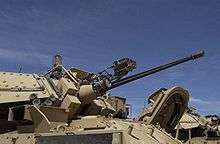
The Bushmaster project started as an offshoot of the US Army's MICV-65 program that was attempting to introduce a new infantry fighting vehicle to replace their existing M113s. Part of this program called for a new scout vehicle to replace the M114, a parallel development taking place under the XM800 Armored Reconnaissance Scout Vehicle. Both the XM800 and the cavalry version of the XM701 MICV vehicles were armed with the M139, a US-built version of the Hispano-Suiza HS.820 20 mm autocannon. During the testing phase, the Army eventually rejected the XM701 and started work on a newer design known as the XM723. Soon after the XM800 was also rejected. This led to the combination of the two programs, moving the scout role to the cavalry version of the XM723.
At the same time, the M139 proved to be disappointing and a contract for a new weapon to replace it started as a competitive development in 1972 simultaneously at Ford Aeronutronic Division (self-powered weapon) and Hughes Helicopters Ordnance Division (externally-powered,)[2] under the Summa Corporation as the Vehicle Rapid-Fire Weapons System-Successor, or VRFWS-S. This was essentially a power-driven gun firing similar 20mm ammunition as the HS.820, the power-driven mechanism would ensure operation even in the case of a misfire.
Progress on the VRFWS-S was slow, and eventually resulted in a switch to a much more powerful 25 mm round. Similar delays in the MICV program meant the ultimate vehicles descending from their efforts, the M2/M3 Bradley Fighting Vehicle, did not enter production until 1981, by which point the Bushmaster had matured. Since 1990, there have been several enhancements made upon the weapon, resulting in the Enhanced 25 mm gun.
To date, more than 10,500 weapons are in service. One of the major reasons for this popularity is the extremely reliable nature of the weapon. It has a rating of 22,000 mean rounds between failure (MRBF), much higher than many comparable devices.
Ammunition
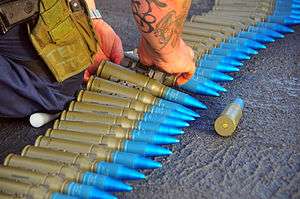
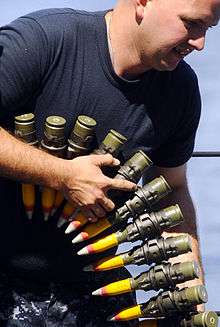
A wide range of ammunition has been developed for this weapon, providing it with the capability to defeat the majority of armored vehicles it is likely to encounter, up to and including some light tanks. The ammunition used in the M242 may also be used in a variety of weapons such as the GAU-12 Equalizer, the French Giat M811, or the Swiss Oerlikon KBA weapon system. It has the capability to fire U.S. manufactured ammunition as well as the NATO equivalents thereof. Primarily though, it fires six types of rounds: the M791, M792, M793, M910, MK210, and M919.
- M791 Armor-piercing discarding sabot with Tracer
- 5.7 million rounds produced
- The APFSDS-T penetrates lightly armored vehicles, self-propelled artillery, and aerial targets such as helicopters and various slow-moving, fixed-wing aircraft.
- M792 High Explosive Incendiary with Tracer and Self Destruct
- 5.5 million rounds produced
- The HEI-T can destroy unarmored vehicles and helicopters and suppress antitank missile positions and enemy squads out to a maximum effective range of 2,200 meters.
- M793 Target Practice with Tracer
- 11.5 million rounds produced
- The TP-T cartridge is a fixed-type, percussion-primed training round that matches the High Explosive Incendiary with Tracer (HEI-T M792) round ballistically. The TP-T's tracer is visible out to 2,000 meters, however, the round has a maximum effective range (accuracy-limited) of 1,600 meters.
- M910 Target Practice Discarding Sabot with Tracer
- The TPDS-T replicates the flight pattern of the M791 Armor Piercing Discarding Sabot with Tracer (APDS-T) round. The TPDS-T allows units to realistically practice sabot engagements.
- MK210 High Explosive Incendiary with Tracer
- 228,000 rounds produced
- Used by the U. S. Navy in their Mk38 naval weapon system.
- M919 Armor-Piercing, Fin-Stabilized Discarding Sabot With Tracer.
- The APFSDS-T round penetrates light armored vehicles, self-propelled artillery, and aerial targets, which includes helicopters and slow-moving fixed-wing aircraft. The dart is made of depleted uranium.
Variants
The M242 is currently in use by the United States Army, Navy, Marine Corps, and Coast Guard, the New Zealand Army, Royal New Zealand Navy, the Norwegian Army, the Spanish Army, the Sri Lanka Navy, the Swiss Army, the Canadian Army, the Australian Army and the Royal Australian Navy, the Israeli Navy, Philippine Navy and Philippine Army, the Singapore Army and Republic of Singapore Navy as well as several others. The wide usage results in several variations and modifications on the standard M242 weapon system.
Ground vehicles
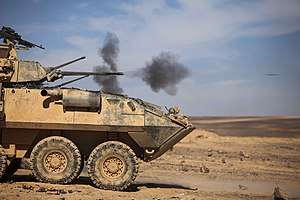
The M242 is standard equipment on the U. S. Army M2 and M3 Bradley fighting vehicles; it is also in use on the LAV-25. Before the project was cancelled, the Mk44 Bushmaster II 30 mm chain gun (a successor to the M242) was used on the Marine Corps' Expeditionary Fighting Vehicle (EFV).
The M242 is also a popular choice of primary armament for armoured fighting vehicles manufactured around the world, such as Singapore's Bionix AFVs and as the Rafael OWS-25 mounted on upgraded M113A2 Ultra IFVs.[5]
Enhanced 25 mm gun
Work on an upgraded weapon began in 1990. In the upgrade program, all three major systems and seven minor systems were improved. The modifications began with introducing a chrome-lined barrel, an enhanced feeder, and an enhanced receiver. The weapon systems also received minor upgrades such as quick-detachable link covers, a larger breech assembly, a high efficiency muzzle brake, longer recoil, an integral round counter, an extended life firing pin and spring, and a triple-spring drive clutch. Upgraded weapons were first put to use on the M2A3 Bradley, the fourth version of the M2 Bradley Fighting Vehicle.
Naval
In 1977, the U. S. Navy realized that it needed a replacement for the Oerlikon 20mm Mk 16 series of guns. In 1986, this requirement was satisfied with the introduction of the Mk 38 Mod 0 weapons system. A derivative of the M242 system, the Mk 38 consists of the M242 chain gun and the Mk 88 Mod 0 machine gun mount. It provides ships with defensive and offensive gunfire capability for the engagement of a variety of surface targets. Designed primarily as a close-range defensive measure, it provides protection against patrol boats, floating mines, and various shore-based targets.
Mk 38 Mod 2 and Mod 3
Recently, several US Navy platforms have been outfitted with a newer version, the Typhoon Weapon System designated Mk 38 Mod 2,[6][7] which is remotely operated and includes an Electronic Optical Sight, Laser Range-Finder, FLIR, and a more reliable feeding system, enhancing the weapon system's capabilities and accuracy. In 2006 the Sri Lanka Navy added the M242 to its fleet of fast attack craft.[8]
The system is also in use by the Republic of Singapore Navy's Formidable-class frigates and Endurance-class landing platform dock ships[9] and were deployed as part of coalition forces' port security efforts in Iraq as well as anti-piracy roles in the Gulf of Aden.[10] Aside from that, the Singapore Police Coast Guard's New Coastal Patrol Craft (NCPC) has adopted the system as its main armament.[11]
The Mod 3 updates electronics and adds a coaxial 7.62mm machine gun with a 570-round-per-minute rate of fire.[12][13][14]
 Weapons station for the remote controlled M242 on the multi-role vessel HMNZS Canterbury
Weapons station for the remote controlled M242 on the multi-role vessel HMNZS Canterbury_1st_Light_Armor_Reconnaissance_Battalion_Landing_Team_(1st_LAR_BLT_1-1)_perform_maintenance_on_Light_Armored_Vehicles.jpg) The United States Marine Corps' LAV-25.
The United States Marine Corps' LAV-25. The Mk38. The M242 has a characteristic fluted gun barrel to reduce weight and assist cooling.[15]
The Mk38. The M242 has a characteristic fluted gun barrel to reduce weight and assist cooling.[15]_ejects_casings_d.jpg) Mk 38 MOD 2 25mm autocannon gun system aboard the amphibious dock landing ship USS Pearl Harbor forward ejecting the spent casings.
Mk 38 MOD 2 25mm autocannon gun system aboard the amphibious dock landing ship USS Pearl Harbor forward ejecting the spent casings.
BAE and Boeing teamed together after a March 2011 contract to add a directed energy weapon to the Mk 38 Mod 2 gun mount, known as the Mk 38 Mod 2 tactical laser system. The TLS combines a Boeing-designed solid-state laser with the existing BAE-manufactured Mk 38 mount to deliver high-precision accuracy against fast surface and air threats including speed boats and unmanned aerial vehicles (UAVs). Laser power levels can be adjusted depending on the target and mission objectives.[16][17] Originally, the system was armed with a 10 kW laser, but in April 2017 BAE announced they had increased power to 60 kW.[18]
Proposed Upgrades
In April 2012, BAE unveiled a potential version of the system mount, developed in collaboration with Rafael Advanced Defense Systems. It is visually distinctive from previous versions with its stealthy housing, which also protects the gun from weather and allows for easier access to internal components through large access panels. The upgrade mounts a larger Alliant Techsystems Mk44 Bushmaster II 30 mm cannon for a 500-meter range increase, as well as a coaxial M2 .50 caliber machine gun. Elevation is increased to +75 degrees for engaging UAVs and helicopters, and ammunition storage is greater at 420 30 mm rounds. Other features include a larger manual fire control panel, an offset mode specifically for firing warning shots, and a surveillance mode where the gun can be pointed away from a target but the EO sensor remains pointed in the target direction. Although it has a high degree of commonality and has the same footprint as previous models, the upgrade is 20 percent heavier due to greater ammo load.[19]
Operators
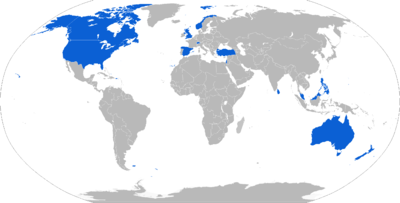
.svg.png)
- Army: ASLAV-25
- Navy: Armidale-class patrol boats, Hobart-class destroyers
.svg.png)
- Army: Coyote reconnaissance vehicle, LAV VI APC
- Navy: Harry DeWolf-class offshore patrol vessel

- Coast Guard: Island-class patrol boat[21]

- Navy: Super Dvora Mk III-class patrol boat, Shaldag-class fast patrol boat

- Army: ACV-300 IFV

- Army: NZLAV
- Navy: HMNZS Canterbury multi-role vessel and Protector-class offshore patrol vessels


- Army: GKN Simba AIFV, M113 APC
- Navy: Gregorio del Pilar-class frigates, Jacinto-class corvette, Mariano Alvarez-class coastal patrol vessel, and Jose Andrada-class patrol craft

- Army: Bionix 25 (replaced by the 30mm Bushmaster II on the Bionix II), M113A2 Ultra IFV
- Navy: Endurance-class landing platform dock, Formidable-class frigate
- Police Coast Guard: New Coastal Patrol Craft (NCPC)

- Army: VEC-M1
- Navy: BAM




- Army: M2/M3 Bradley
- Navy (Mk. 38 Mod 0, Mk. 38 Mod 2 and Mk. 38 Mod 3): Nimitz-class aircraft carrier, Arleigh Burke-class destroyer, Ticonderoga-class cruiser, Oliver Hazard Perry-class frigate, Wasp-class amphibious assault ship, Tarawa-class amphibious assault ship, Whidbey Island-class dock landing ship, Harpers Ferry-class dock landing ship, Austin-class amphibious transport dock, Blue Ridge-class command ship, Cyclone-class patrol ship, Mark VI patrol boat
- Marine Corps: LAV-25
- Coast Guard (Mk. 38 Mod 0, Mk. 38 Mod 2 and Mk. 38 Mod 3): Reliance-Class cutter, Hamilton-class cutter, Sentinel-class cutter, Island-class cutter, USCGC Alex Haley, future Heritage-class cutter[22]
See also
- M230 30 mm automatic cannon
- Bushmaster II 30 mm chain gun
- Bushmaster III 35/50 mm chain gun
- Bushmaster IV 40 mm chain gun
- 30mm DS30M Mark 2 Automated Small Calibre Gun British automated mount with 30mm Bushmaster II
- List of weapons of the United States Marine Corps
- List of crew-served weapons of the U.S. Armed Forces
References
- Notes
- Chinn, George M., 1987, pp. 455–456.
- Fiscal Year 1977 Authorization for Military Procurement, pt. 6., p. 3242.
- "Trademark Assignment Abstract of Title". United States Patent and Trademark Office. 12 November 2018. Archived from the original on 7 May 2016. Retrieved 28 April 2019.
- "Northrop Grumman M242 25mm BUSHMASTER chain gun fact sheet" (PDF). 2018. Archived (PDF) from the original on 28 April 2019. Retrieved 28 April 2019.
- "Factsheet – Technical Specifications of Ultra M113" (Press release). Ministry of Defence, Singapore. 16 June 1998. Archived from the original on 25 October 2017. Retrieved 28 October 2010.
[Last updated on 12 June 2010]
- "Mk 38 Mod 2 Machine Gun System (MGS)". BAE Systems. Archived from the original on 8 March 2009. Retrieved 24 October 2010.
- "Archived copy" (PDF). Archived from the original (PDF) on 2 December 2012. Retrieved 26 August 2010.CS1 maint: archived copy as title (link)
- Sri-Lanka learns to counter Sea Tigers’ swarm tactics, JANE’S NAVY INTERNATIONAL Archived 3 November 2011 at the Wayback Machine, Jane's Information Group.
- "RSN – Assets – Weapons". Ministry of Defence (Singapore) (MINDEF). 23 July 2010. Archived from the original on 20 July 2008. Retrieved 15 September 2010.
- "The Next Wave". MINDEF. 6 May 2010. Archived from the original on 14 October 2017. Retrieved 15 September 2010.
- Muhammad Juffry, Bin Joihani (July–August 2009). "PCG upgrades with new fleet and training centre". Police Life Monthly. Singapore: Singapore Police Force. 35 (7). ISSN 0217-8699. Archived from the original on 22 June 2011. Retrieved 8 November 2010.
- "MK 38 – 25 mm Machine Gun System". United States Navy Fact File. Archived from the original on 3 November 2018. Retrieved 6 April 2019.
- "Mk 38 Mod 3 Machine Gun System (MGS)". BAE Systems. Archived from the original on 6 April 2019. Retrieved 6 April 2019.
- "Contracts for June 29, 2018". U.S. Department of Defense Search Defense.gov: Search. Archived from the original on 6 April 2019. Retrieved 6 April 2019.
- Joel Avila,1LT(P) EN, USAR. "The Real Benefits of Barrel Fluting". www.snipercountry.com. Archived from the original on 24 October 2014. Retrieved 25 August 2014.CS1 maint: multiple names: authors list (link)
- BAE Putting Lasers on Mk 38 Naval Gun Archived 12 November 2014 at the Wayback Machine – Defensetech.org, 25 July 2011
- Boeing and BAE team up to develop laser weapon for the U.S. Navy Archived 2 November 2014 at the Wayback Machine – Gizmag.com, 26 July 2011
- BAE Systems Unveils a 60 kW Variant of the MK 38 Tactical Laser System Archived 6 April 2017 at the Wayback Machine – Navyrecognition.com, 4 April 2017
- BAE Systems Developing Next Generation Mk 38 Gun Mount Archived 3 April 2015 at the Wayback Machine – Defensemedianetwork.com, 24 September 2012
- Wertheim, Eric, ed. (2007). The Naval Institute Guide to Combat Fleets of the World: Their Ships, Aircraft, and Systems (15th ed.). Annapolis, MD: Naval Institute Press. p. 22. ISBN 978-1-59114-955-2. OCLC 140283156. Archived from the original on 6 July 2014. Retrieved 25 October 2016.
- "Archived copy". Archived from the original on 12 December 2017. Retrieved 19 August 2017.CS1 maint: archived copy as title (link)
- "MK 38 – 25 MM MACHINE GUN SYSTEM". Navy.mil. US Navy. Archived from the original on 17 February 2017. Retrieved 16 February 2017.
- Bibliography
- Chinn, George M. (Lt.Col., USMC, Retd), ed. (1987). The Machine Gun: History, Evolution, and Development of Manual, Automatic, and Airborne Repeating Weapons (PDF). Vol. V. Ann Arbor, Michigan: Edward Brothers Publishing Co. Retrieved 28 April 2019.
External links
| Wikimedia Commons has media related to M242 Bushmaster. |